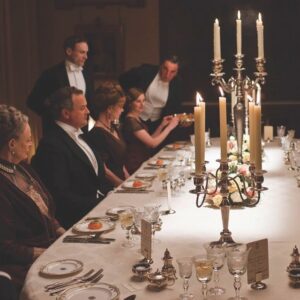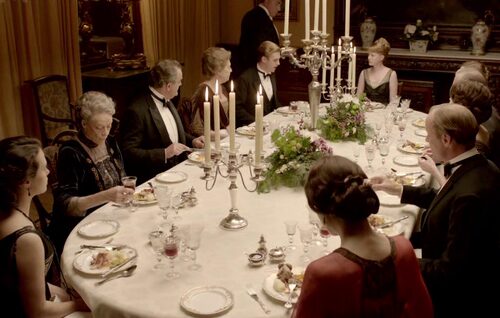
Pre-War Service (1912-1914)
During the height of Edwardian elegance, Easter dinner would have been a formal 8-10-course affair:
Menu:
- First Course: Clear turtle soup or consommé royale (with tiny cubes of royale custard)
- Fish Course: Poached salmon with mousseline sauce or sole Véronique (with white grapes)
- Entrée: Quail en croûte or lamb cutlets with asparagus tips
- Relevé: Roast spring lamb with mint sauce and new potatoes
- Game Course: Roast pheasant or guinea fowl (if in season)
- Vegetable Course: Fresh peas, asparagus spears, and glazed carrots served separately
- Sweet Course: Simnel cake, Charlotte Russe, and fruit compotes
- Savory: Welsh rarebit or anchovy toast
- Dessert: Fresh fruits, nuts, and petits fours
- Coffee and liqueurs served afterward
Service would involve multiple footmen in formal livery, with white gloves, serving simultaneously from the left on cue from Carson.
War Years (1914-1918)
The Great War brought significant changes, with rationing imposed in 1917-1918:
Menu (simplified):
- Mock turtle soup (economizing on meat)
- Baked fish with parsley sauce (often local fish rather than imported)
- Roast lamb (smaller portions) with mint jelly
- Vegetables from the kitchen garden (emphasis on home production)
- Eggs en cocotte (replacing more elaborate entrées)
- Simnel cake (made with reduced sugar and fewer dried fruits)
- Apple snow (using preserved fruits and less cream)
Service would have been handled by remaining staff, often including women filling in for enlisted men, with fewer synchronized flourishes.
Early Post-War (1919-1924)
With many servants not returning to service and social changes accelerating:
Menu:
- Celery soup with cream
- Salmon mousse or trout with almonds
- Crown roast of lamb with redcurrant jelly
- New potatoes with mint
- Spring vegetables in season
- Nesselrode pudding (chestnut purée with cream and fruits)
- Simnel cake (returning to pre-war richness)
- Cheese board with biscuits (replacing separate savory course)
Service would have fewer footmen, perhaps 2-3 rather than 4-6, with courses brought from the kitchen more sequentially rather than simultaneously.
Late 1920s (1925-1929)
By this period, even aristocratic households had adapted to the new era:
Menu:
- Chilled asparagus soup or clear consommé
- Lobster thermidor (influenced by continental cuisine becoming fashionable)
- Roast lamb with rosemary and garlic (less traditional preparations gaining acceptance)
- Duchesse potatoes and spring vegetables
- Light lemon soufflé or pineapple upside-down cake (American influences)
- Traditional Simnel cake served at tea rather than dinner
- Coffee served in the dining room rather than separately
Service would be more relaxed, with guests often remaining together after dinner rather than separating by gender. Dinner might be served at 8:30 rather than the earlier Edwardian hour, and black tie would be more common than white tie except for the most formal occasions.
The elaborate pre-dinner ritual of being announced by Carson would remain but with less ceremony. By the late 1920s, cocktails before dinner would be served, something unheard of in 1912.
These changes reflected not just war’s impact but the accelerating social transformation of Britain between the wars, where even traditional aristocratic households had to adapt to changing times, increasingly influenced by American customs and the growing informality of the Jazz Age.
